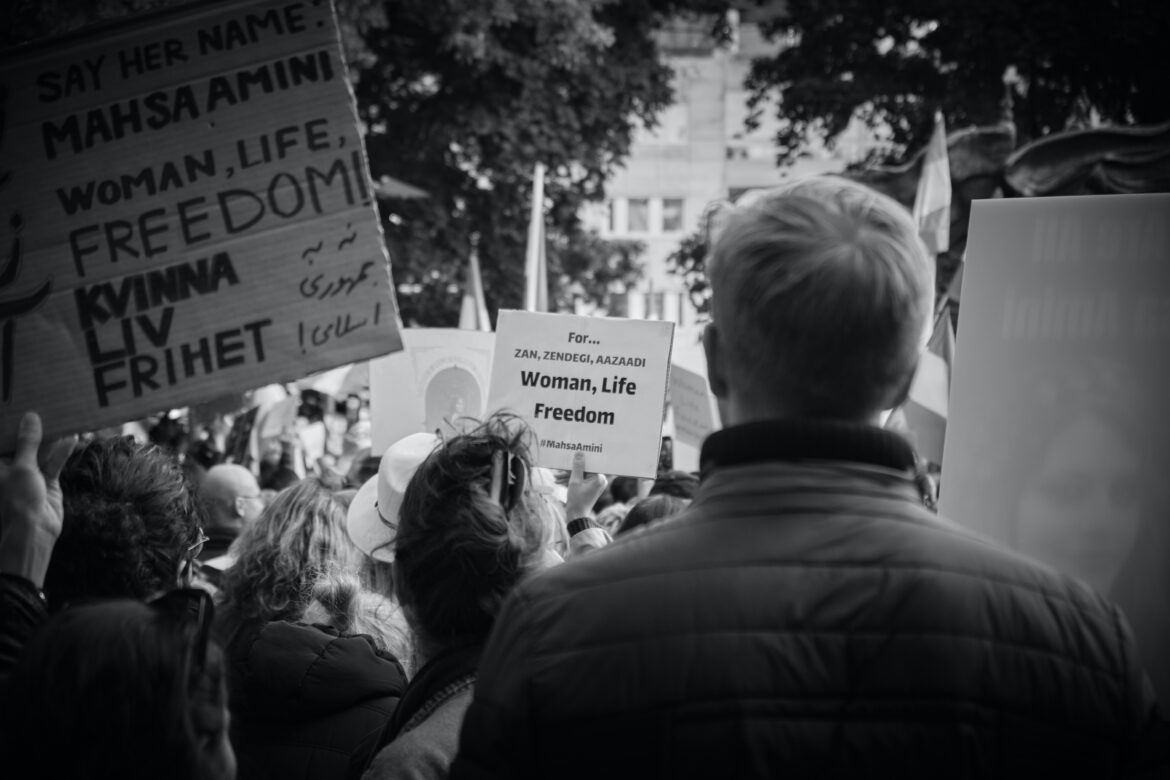On 22 October 2022, the Guggenheim Museum was swarmed with its typical sightseers cherishing the usual art collection until 12 vivid red banners cascaded down four floors, grabbing everyone’s attention. Each banner intricately displayed the portrait of Mahsa Amini, the 22-year-old who died at the hands of Iran’s ‘morality police’ for not wearing her hijab correctly. Alongside her flawlessly traced portraits, the caption read, “Women, Life, Freedom,” (translated from Kurdish to English) and has officially become the powerful slogan among young protestors against Amini’s death in Iran. This incident has been the root of various unprecedented protests observed at the national and global levels.
This event is the most recent example of how art can be incorporated into socio-political movements, notably the ‘Hijab Movement.’ Through art, the movement aims to support women’s freedom with regard to choosing their own attire. In other words, the fury over women’s lack of choices has manifested itself in various forms, including paintings, sculptures, performances, and other artworks in physical spaces and across social media platforms.
One of the most macabre series of artwork is indisputably ‘Tehran Covered in Blood. Titled by Twitter users, fountains across Tehran have been transformed into pools of murky red. Interestingly, the colour symbolizes death, thereby reinforcing the gruesomeness of Amini’s death. Eminent examples of the blood-soaked fountains include water fountains in Daneshjoo Park, Shahr Theatre, Fatemi Square, and Artists’ Park. Despite heightened security forces among the public and digital limitations, especially among activists, journalists, and reputed supporters, images of the blood-red fountain have continued to circulate across the country, instigating mass protests.
In addition, one of the central motifs of the protests is hair — which stemmed from Amini showing more hair than she was permitted. Consequently, lustrous, wild, and free hair is a recurring theme in the various displays of artistic protest. An intriguing illustration of this is seen in artist Mahdieh Farhadkiaei’s ‘playing card’ piece. Through an adaption of the ‘Queen of Hearts’ playing card, Farhadkiaei presents the same lone queen melancholically chopping off her luscious hair. This is impactful because according to Iranian tradition, women have historically cut their hair during periods of remorse. Over the past month, women snipping lengths of their hair has become a frequent phenomenon, making this art piece overwhelming, upsetting, and tangible. Moreover, the act has also become a symbol of bodily autonomy and unwillingness to accept a repressive paternalistic system.
Conversely, countries like India and France are vulnerable to pro-hijab demonstrations. This strongly counters the Western rhetoric of the hijab being a representation of suppression and abuse. In reality, many women classify it as a token of Islamic identification and pride, consequently striving to secure their religious rights and freedom of expression.
A glaring example of these demonstrations is the mysterious ‘slapping paint’ of the black Muslim veils on semi-nude airbrushed advertisements in Paris. Under the pseudonym ‘Princess Hijab,’ this elusive graffiti artist is notoriously known for striking at midnight to advocate for her pro-hijab views through the display of satirical graffiti in metro stations. The Princess’s “niqabisation” (a term coined by the princess), or rather her first veiled graffiti, was the album poster of France’s widely recognized female rapper, Diam’s. Due to Paris metro’s tight security and overall protection of advertisement spaces, her pieces now linger merely briefly until they are annihilated by officials. In an attempt to remain unidentified by officials and the general public, the princess paints only four or five graffitis annually. Nonetheless, each piece is thoroughly photographed and digitalized, thus immortalizing her art.
Similarly, in India, Bengaluru-based artist Shilo Shiv Suleman has founded the ‘Fearless Collective.’ This initiative aims to address the hijab ban in Karnataka and raise awareness of the significance of the hijab for Muslim women in the state. The mass advocacy is predominantly tailored to social media platforms and has garnered immense attention, expanding to the Non-Fungible Token (NFT) arena. The collection sold as NFTs includes photographs of Muslim women wearing their hijab. In addition to NFTs, the women also share their personal stories in order to trigger the sentiments of the general Indian public.
This piece has shown that the hijab poses a direct dichotomy. On the one hand, it symbolizes religious expression, but to some, it represents the patriarchal constriction of women and their clothing attire. While countries continue to fight against rigid pro or anti-hijab laws, the overarching, rudimentary idea is that it must always be the women’s choice. Art has been medium to fight for the fundamental right to freedom of choice and individual autonomy without the interference of patriarchal constrain or norms. The amalgamation of symbolism, creativity, and imagination compels the audience to reflect on their beliefs, thereby stimulating an urgency to bring about transformational changes.
Edited by Anyssa Boyer
Rashi Lalan is in her second year at McGill University and is pursuing a degree in Economics as well as International Developmental Studies. She is a staff writer for Catalyst and is particularly interested in South Asian politics and culture.

